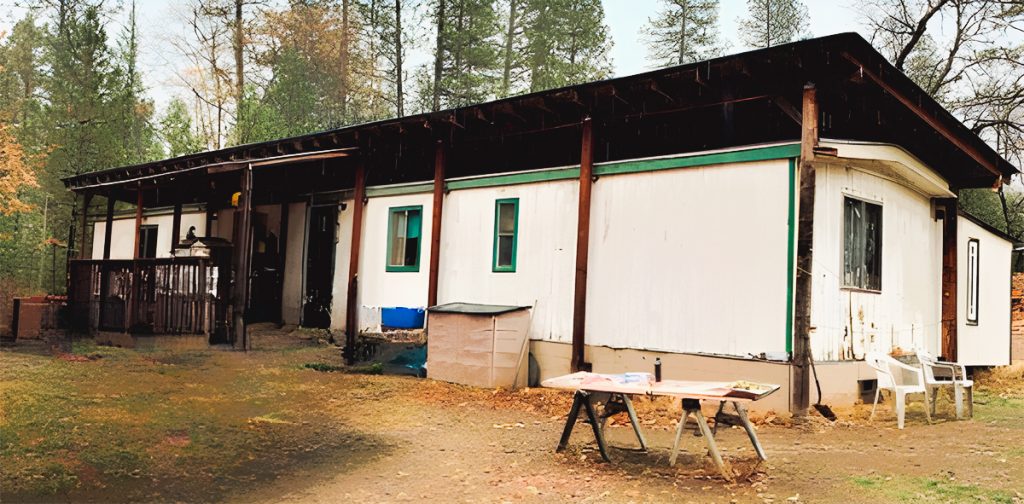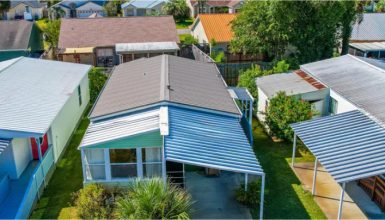Ready to take your mobile home living to the next level? You’re in the right spot. We’re cracking the code on one of the most significant upgrades to your home on wheels—a roof over. Now, we’re not just talking about any upgrade; we’re diving into an essential, game-changing move that could redefine how you view your mobile abode.
But first, let’s clear the air. What’s a roof over? Simple. It’s your mobile home’s protective layer, the helmet to your star quarterback, the umbrella in a rainstorm. It’s a second roof built over your existing one—boosting comfort, increasing durability, and turning your temporary haven into a cozy, long-term nest.
Mobile Home Roofing Basic
So, let’s dive deeper. To understand why roof overs are the bee’s knees of mobile home improvements, we first need to get our hands dirty with a bit of Mobile Home Roofing 101.
Now, picture your mobile home. What’s its crown jewel? That’s right, the roof. It’s your home’s first defense, keeping you dry when it rains, cool under the blazing sun, and warm when winter chills creep in. But not all mobile home roofs are created equal, and understanding the differences is crucial.
First, mobile homes have two major types of roofs – flat and pitched. Flat roofs are exactly as they sound, flat as a pancake, while pitched roofs have that classic roof shape, rising into a peak.
Flat roofs might be the original cool kid on the block, often seen in older mobile homes, but they have their share of problems. They aren’t great at shedding water; pooling can lead to leaks. On the other hand, pitched roofs, often seen in newer models, are great at fending off water but can be a bit pricier to maintain.
But here’s the twist. Whatever type you have, both roofs face some common issues. We’re talking potential leaks and less-than-stellar insulation, and don’t even get me started on the weather damage. It’s like sending your roof into battle without a shield!
That’s where the roof over overcomes in, like a knight in shining armor. But we’ll dive into those details later. For now, just remember: Understanding your current roof, with all its strengths and weaknesses, is the first step towards a successful roof over.
Benefits of a Roof Over for Mobile Homes
Now that we’ve covered the basics of mobile home roofing let’s get to the fun part. Why should you even consider a roof over for your mobile home? Are there benefits? You betcha! Here are a few that will make you say, “Wow, I need a roof over, like, yesterday.”
- Energy efficiency
First up, let’s talk about energy efficiency. Who doesn’t like saving money on energy bills? With a roof-over addition, you add an extra insulation layer to your home. It means less air sneaking in or out. Your AC will thank you in the summer, and your heater will give you a high-five in the winter.
- Weather protection
Next up weather protection. Picture your roof as your home’s superhero, taking on the elements day in and day out. A roof over provides an additional layer of armor, making it tougher for rain, snow, and sun to cause damage. Your roof’s lifetime? Consider it extended.
- Curb appeal
Then there’s the curb appeal. Your home is more than just a place to live; it reflects you. A roof over can make your mobile home look like a million bucks, adding aesthetic value that makes you proud to say, “Yep, that’s my home.”
- Increase value
Finally, let’s talk dollars and cents. A roof over can increase the value of your mobile home. If you ever decide to sell, buyers will appreciate the extra care you’ve put into maintaining and enhancing the home.
So, in a nutshell, a roof over is like a magic potion for your mobile home. It boosts energy efficiency, offers added protection, enhances your home’s looks, and even increases your home’s value. Talk about a win-win-win-win!
Signs Your Mobile Home Needs a Roof Over
So, now you’re thinking, “These benefits sound awesome! But how do I know if my mobile home needs a roof over?” Great question, my friend. Here are a few signs to watch:
- Leaks
First up, leaks. If it’s raining indoors just as much as outdoors, you might need a roof over. Water spots on the ceiling, peeling wallpaper, a funky smell – all signs water is sneaking where it shouldn’t be.
- Can’t maintain temperature
Then there’s temperature control. Is your home impersonating an icebox in winter and a sauna in summer? That’s a clue! Suppose your heater and AC work overtime but can’t maintain a cozy temperature. In that case, it might be time for a roof over.
- Roof sagging
Notice any sagging in your roof? That’s another sign. It can indicate water damage or structural problems. And if your roof looks more like a patchwork quilt because of all the repair jobs, that’s your roof saying, “Hey, how about a little help here?”
- Increased energy bills
Lastly, take a good look at your energy bills. If they’ve been steadily climbing, your roof might be the culprit. Poor insulation means more energy is spent on heating and cooling, and nobody wants that!
These are just a few signs; your mobile home might show one or all. The key takeaway? Keep a keen eye on your roof and its performance. If things aren’t looking so hot, a roof over might just be the superhero your home needs.
Selecting the Right Materials for Your Roof Over
You’ve seen the signs and are ready to take the plunge. But wait, don’t rush in just yet. One of the most important decisions you’ll make in this process is selecting the suitable material for your roof over. Let’s check out some of the top contenders:
- Metal Roofing
Think of it as the heavyweight champ in the roofing world. It’s durable, long-lasting, and a great conductor of heat, making it a standout for energy efficiency. But it’s a bit pricier and can be noisy during rainstorms.
- Rubber Roofing
It is the quiet achiever of roof overs. Rubber roofing is excellent for insulation, low maintenance, and long lifespan. Plus, it’s a champ at keeping water out. The downside? It’s not the most glamorous looking.
- Shingle Roofing
Shingles might be your pick if you’re after that classic, homey look. They come in various styles and colors and are relatively easy to install. The downside? They’re not the best match for flat roofs and can require more upkeep.
- Membrane Roofing
A solid choice for flat roofs, membrane roofing is a hit with superior waterproofing. It’s also durable and requires little maintenance. The downside? It’s not as attractive as other options and can be a bit costly.
Choosing a suitable material is a bit like matchmaking. You need to consider your mobile home’s needs, your climate, your budget, and, of course, your taste. The goal is to find a material that’s a perfect fit – or as close to perfect as you can get.
Self-Supported Mobile Home Roof Over Design
As the name suggests, self-supported roof overs stand on their own two feet—or, rather, their own independent set of posts or pillars. They’re like a giant umbrella over your mobile home, not relying on your existing roof for support. This design adds extra security and stability, especially in areas prone to heavy snow or strong winds.
The primary benefit of self-supported roof overs is the potential to create additional living space. Think of it: a spacious attic, beautiful loft, or handy extra storage. Plus, this design allows for better ventilation, which can further improve the energy efficiency of your mobile home.
Let’s dive into some of the most popular self-supported mobile home roof-over designs.
1. A-Frame Roof Over
Source: hansenpolebuildings
Also known as a gabled roof, the A-Frame design is a classic. Its peaked structure (hence the ‘A’) offers a traditional look. This style is excellent for shedding rain and snow, and you can utilize the attic space beneath for storage or additional living space.
2. Gambrel Roof Over
Have you ever seen a barn with a roof with two slopes on each side? That’s a gambrel roof. The design is visually striking and provides plenty of extra space underneath. A great choice if you’re aiming for a rustic charm!
3. Shed Roof Over
Also known as a lean-to roof, this design slants in one direction. It’s a simpler, cost-effective design that’s quick to install. While it doesn’t offer as much extra space as an A-Frame or gambrel, it still provides good protection and improved ventilation.
4. Flat Roof Over
While flat roofs can be a bit simpler in design, don’t underestimate their practicality. They’re easy to construct and cost-effective, plus they can be used as a base for solar panels or even a green roof.
5. Hip Roof Over
A hip roof has slopes on all four sides, coming together at the top to form a ridge. This design is more stable than others, making it a good option in areas with high winds or hurricanes.
6. Mansard Roof Over
A mansard roof is essentially a hip roof with two slopes on each side, the lower slope being steeper. This French-inspired design can add a touch of elegance to your mobile home and provide ample extra space.
Mobile Home Roof Over Cost
Money talks, right? We’ve all heard the phrase, “You get what you pay for.” Nowhere is this truer than in-home improvements. So, before we start tossing dollar bills around, let’s dive into what a roof over might cost and what you get for that investment.
First things first: the cost of a roof over can vary—big time. Think of it as buying a car. Are you after the primary, gets-the-job-done model? Or are you looking for a high-end, all-bells-and-whistles ride? Much like cars, the price of a roof over can range based on the materials you choose, the design, the size of your home, and even your location.
Now, for a ballpark figure, you could be looking at anywhere from $1,000 for a super basic, DIY job, up to $10,000 or more for a high-end, professional installation. Remember, these are rough estimates, and prices can fluctuate.
So, why such a wide range? Well, materials play a big part. Metal roofing, for example, tends to be more expensive than rubber or shingle roofing. The design of your roof over can also impact the cost. A simple shed roof design will likely be cheaper than an A-frame or gambrel roof.
Professional installation is another factor. Going the DIY route can save you some bucks upfront but ensure you know what you’re doing. A poorly installed roof over can lead to headaches down the road. Professional installation can be expensive, but you pay for expertise and peace of mind.
Now, let’s look at the flip side—the return on your investment. Energy savings, increased home value, and reduced maintenance costs can offset the initial expense. Plus, the added comfort and protection for your home? That’s priceless.
Conclusion
The best roof-over design depends on your specific needs and preferences and the characteristics of your mobile home and site. Remember, a roof over is an investment in your mobile home, comfort, and future. So, take the time to understand the costs, weigh your options, and make the best decision. After all, a roof over is more than just an expense—it’s a long-term investment in your home sweet (mobile) home.





























